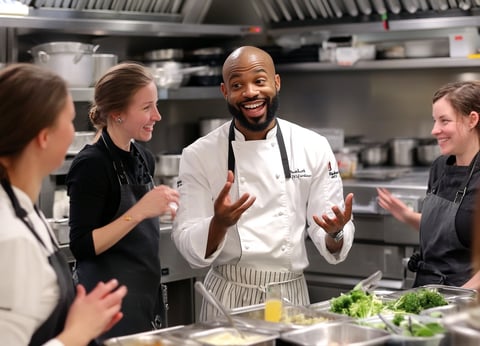

The 30-Second Power Move: How to Make People Listen Instantly
Steve Weiss, ACC
Transformational Leadership Academy
Like it or not, people decide whether to respect you in the first 30 seconds. Get it wrong, and you’re ignored. Get it right, and you own the room. Here’s how to make them listen—fast.
Step 1: Own the Space Before You Even Speak
🔹 Enter with purpose. Walk into the room like you belong there—steady, controlled, and confident. In a kitchen, this means moving with intention, not hesitation. A head chef or leader in the BOH (Back of House) sets the tone with their body language and presence.
🔹 Plant yourself. Stand or sit with confidence—no fidgeting, no shifting. In the culinary world, a leader commands respect by knowing exactly where they need to be and projecting certainty.
🔹 Make eye contact before you talk. Scan the room. Let people feel your presence before you say a word. This triggers dominance signals in human psychology, crucial in high-stress kitchen environments.
Culinary Example: Great chefs don’t rush into giving orders—they observe, assess, and then speak. Watch how a top chef enters a kitchen—calm, in control, assessing everything before saying a word.
🔥 Your challenge: Next time you walk into a kitchen, pause, scan the space, and let people register your presence.
Step 2: Start With Impact—Not Small Talk
🚫 Weak Openers to Avoid:
"Uh, okay, so, um, I just wanted to talk about…"
"Hey, so, yeah, uh, let’s get started…"
"I know we’re all busy, but I just wanted to say…"
🔥 Power Openers That Command Attention:
A bold statement. → “Tonight’s service depends on precision—let’s get it right.”
A surprising fact. → “The number one reason tickets back up isn’t speed—it’s lack of communication.”
A question that demands engagement. → “What’s the one thing that slows down our line the most? Fix that, and we win tonight.”
Culinary Example: Gordon Ramsay doesn’t start a service with, "Okay, let’s have a good night." He dives straight into focus mode. Watch how great executive chefs speak—they get straight to the point, ensuring their team is locked in from the start.
🔥 Your challenge: Before you speak in a kitchen, plan your power opener.
Step 3: Command Attention with Your Voice and Body
🔹 Drop the "question" tone. If your sentences rise at the end? You sound unsure. Own your words.
🔹 Speak slower. Nervous people rush. Confident people control the pace.
🔹 Use silence. After a big statement, pause and let it sink in.
Culinary Example: The best chefs don’t shout to be heard—they lower their voice and slow their words, forcing the kitchen to lean in and listen. Thomas Keller, for example, is known for his controlled, precise communication. The calmer the leader, the more powerful their influence.
🔥 Your challenge: Record yourself giving kitchen instructions. Listen for upspeak, rushing, or weak volume. Then fix it.
Step 4: Make People Feel Like They Matter
Want instant engagement? Make the people in front of you feel important.
🔹 Call people by name. → “Marco, I need you focused on timing tonight.”
🔹 Acknowledge the team. → “I know we’re all dealing with extra tickets tonight. Let’s stay locked in.”
🔹 Give them a role. → “Sous chefs, I need updates every five minutes. Line cooks, let’s keep this moving.”
Culinary Example: In the best kitchens, a leader makes everyone feel valued—whether it's a line cook, a sous chef, or the dishwasher. When people feel seen, they perform better. A head chef who acknowledges their team creates loyalty, not just obedience.
🔥 Your challenge: Next time you lead in a kitchen, mention people directly. Pull them in.
🔥 Final Thought: The First 30 Seconds Are Your Leadership Test
How you enter the kitchen tells people if you’re worth listening to.
Your first words decide if people care or check out.
Your voice, presence, and engagement make or break your influence.
Great leaders don’t wait for respect—they create it in the first 30 seconds.
So next time you step into the kitchen—own the moment.
Contact Info
steve@leadwithtla.com
216-288-4548
